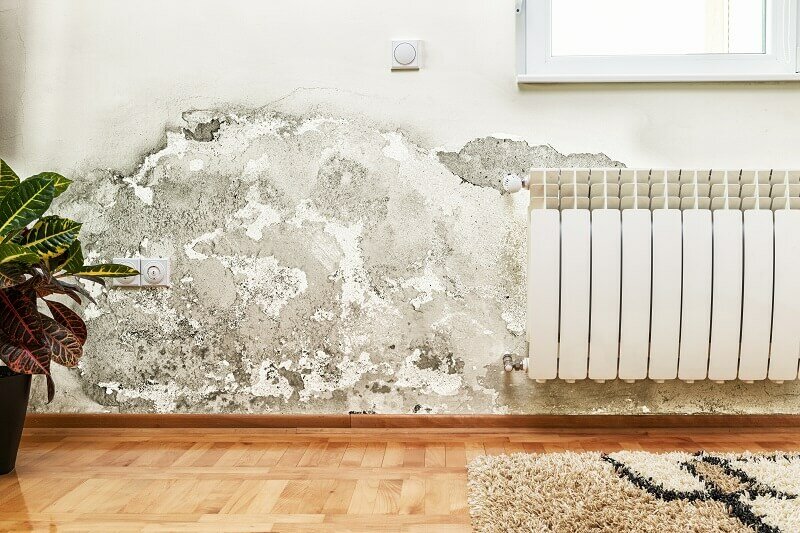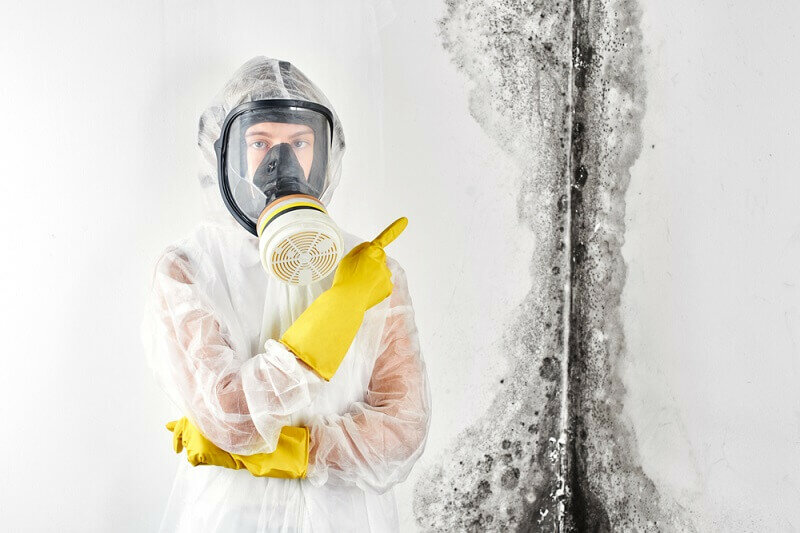Selling a house is a grand feat and the start of a new chapter for both home sellers and buyers. Selling a house with mold is not the most ideal situation, but it isn’t impossible. Selling your house with mold or mold damage doesn’t have to be as daunting as it seems if you approach mold issues prudently.
Real estate laws and regulations may vary from state to state. Vermont real estate agents can fill you in on the ins and outs of selling a house with mold in Vermont.

Upon discovering the presence of mold issues in your home, you may wonder: Can you sell a house with mold? Is it illegal to sell a house with mold in Vermont? Can you sell a house as-is with mold?
Well, we’re here to answer all of those questions and help you on your house selling journey by teaching you the best ways to sell your house fast in Vermont.
Selling a House with Mold in Vermont
Selling a house with mold in Vermont is legal. However, you must disclose mold and mold damage issues with official documentation so that home selling is a legitimate and transparent transaction in which both parties are aware and thus protected from potential legal issues.
The first step in selling your home should be contracting an inspector to execute a pre-sale home inspection. If they detect mold or mold damage, this gives you, as a seller, the ability to disclose such information before the buyer performs a separate home inspection. You, therefore, have the foresight you need to decide if you want to perform mold damage remediation yourself or sell your house with mold damage as it is.
You can approach selling your house with mold in Vermont the same way you would sell a home without it, you have options to sell it yourself, sell it to an investment company, or you can use a real estate agent.
It is the best idea to use a real estate agent when selling a house with mold because real estate agents are well-versed in legal protocols and can facilitate the creation of a proper and thorough disclosure agreement.
If you’re looking to sell a house fast, you can also consider cash home buyers in Burlington. This is a great alternative to putting your house on the open market and dealing with the stress of selling.
Why sell your house for cash? Though you may receive a lower offer price on the home, it can save you the costs of a real estate agent or any repairs that need to be made due to mold damage. You’ll receive the money quickly to put towards purchasing a new home without the worries of taking care of the old one.
Assess the Damage of Mold to Your House
As homeowners, if you notice mold growing in any area of your home, you should bring in a specialist to assess the damage of mold to your house. Damage caused by mold can be artificial, structural, and in the most serious cases, a health hazard. Here, we’ll go over the types of mold you might find and how mold damage could affect your home.
Types of Mold
Mold is a broad term that refers to various types of fungi that grow on surfaces and release spores or particles into the air. There are hundreds if not thousands of mold species, the majority of which are harmless or even beneficial to the environment.
Mold grows everywhere, and exists in most homes, albeit in negligible amounts. Unfortunately, mold proliferates quickly and easily, and the more it grows, the more at risk your home becomes for damages caused by mold.
Upon executing a mold damage assessment, an inspector or mold specialist renders a mold damage review of their findings which includes:
- Visual observations
- Moisture and humidity assessment
- Measurements of mold and spore count
- Sampling of mold
For health purposes of mold damage assessments, specialists classify three main mold types:
- Allergenic- The least dangerous molds that may have little to no effect on most people, but still affect many individuals with mold allergies and asthma.
- Pathogenic- Molds that present health hazards for weak and strong immune systems alike. Depending on the type of pathogenic mold, they can cause pulmonary infections, pneumonia, meningitis, and many other chronic upper respiratory illnesses.
- Toxigenic- The most hazardous forms of mold that contain the chemical mycotoxin which presents a deadly threat to humans and animals if inhaled. The infamous “black mold” variety lies in this category.
Structural damage caused by mold in your home likewise comes in many forms. Because mold is a living organism, it must feed to survive. Damage occurs as the mold consumes the structures, furniture, ceilings, or flooring on which it grows.
While you can assess the damage of mold to your house with an over-the-counter kit, we recommend hiring a professional.
Find Source of Mold
Mold flourishes in hot, humid, and moist environments, so its favorite spots include bathrooms, kitchens, drains, basements, and attics. Lack of light, poor ventilation, and water leaks are the leading causes of mold issues in the mold.
When investigating mold issues, you want to look for the source of mold in your home so that you can not only eliminate the mold from spreading, but also fix the conditions that instigate its growth.
Mold sources arise for various reasons. For example, older homes with cement foundations accrue cracks over time, and mold grows easily in these dark, dank crevices. The location of your home also could enhance the propensity for mold issues. For example, homes close to a river or lake, or homes that lay at the bottom of a hill are more prone to flooding or collecting stagnant water.
New renovations such as converting your home’s energy-saving systems have become a source of mold damage, as rerouting insulation or closing off unnecessary vents in your attic also cuts off airflow. Cutting off airflow to a dark space creates a hospitable environment for mold.
The bottom line is that water in liquid or vapor form is the source of mold and the cause of its proliferation. The sooner you control the moisture in your home, the better your chances are of preventing mold damage.
Fixing Mold on Your House
Fixing mold damage involves removing mold, repairing mold damage, and taking measures to prevent the resurfacing of more mold issues. Depending on the size of your mold issue, you may be successful in repairing mold damage yourself. However, fixing mold on your house is generally more complex than you think, and should be left to a certified mold remediation company.
That said, we will give tips for DIY mold fixing and moisture control along with price estimates should you seek professional help in fixing mold in your house.
DIY
The EPA gives a thorough guide on fixing mold damage that you should consult if you plan on repairing mold damage yourself. However, they emphasize that you should only attempt mold fixing yourself if the mold damage covers an area no greater than 10 square feet.
The instant you notice mold, you should remove the visible mold and clean the affected area as quickly as possible. More importantly, you need to repair the source of mold, whether it be water leakage, poor ventilation, or recurring humidity and moisture.
You can use simple detergent to scrub away visible mold, rinsing the area with water, and drying it completely. The main issue is controlling the cause of moisture that instigated mold growth, which could mean repairing gutters, plumbing, HVAC systems, or simply investing in dehumidifiers and standing fans for dark, poorly ventilated rooms.
Professional Mold Damage Remediation
The reason we recommend professional mold remediation is because mold releases spores into the air when cleaned off surfaces, and spores pose the health hazards we discussed earlier. Remediation companies have the proper equipment to prevent inhalation of spores during cleaning. They also know how to remove mold while maintaining your home’s structural integrity.

Mold remediation services range from $500 to $4000, depending on the size of the damage. The sooner you begin fixing mold damage, the smaller your costs will be. Undetected or neglected mold growth can result in bills as large as $7,000. Whether you plan on fixing mold damage before selling your house or not is up to you, but buyers will likely want you to cover remediation costs as part of the house sale agreement.
Documenting Solving Mold Problem
Whether you hired a mold remediation company for mold removal, had a mold inspection, or did mold repair yourself, it is pivotal that you document mold repair so that you can provide confirmation of mold repair in your disclosure for potential home buyers.
Mold repair documentation consists of disclosing the presence of mold issues or mold damage in the home as well as the steps you have taken in repairing house mold to potential buyers. Mold repair proof consists of the following documentations:
- Visual documentation (either photographs or videos) of mold and mold damage before removal or repair
- Written or typed documentation of repair procedures you or the repair company executed to eliminate mold infestation
- Receipts and official reports from the mold remediation company that repaired the mold damage
- Proof of moisture control or other current protocol to prevent re-infestation
If you use a mold remediation company, you must ensure that they have the proper IICRC as well as environmental insurance coverage to protect the company and your home in the case of cross-contamination during remediation.
Inform House Buyers of Previous Mold Issue
As we discussed in the first section, Vermont law requires you to inform house buyers of previous mold issues. Disclosing previous mold issues, no matter how insignificant or grave they were, will protect both sellers and potential house buyers from nasty court disputes that would occur if the house buyers did not know you are selling a house with mold damage.
There are official mold disclosure documents that your real estate agent can assist you in obtaining and filling out. This could also include documentation that shows proof of mold repair, like pictures, receipts, and mold reports from a remediation company.
Disclosure means telling house buyers about previous or ongoing mold issues, and either stating that you are selling a house with mold damage as is or performing mold remediation yourself and providing physical proof that mold repair has been done.
Selling a house with mold is easier to do if you are upfront about mold issues from the onset of negotiations. Not only can you sell a house with mold without disputes, but house buyers are far more likely to accept or engage in fair negotiations for a house with mold if they have all the facts.
Conclusion
Mold comes in various forms, causing health, structural, and superficial damage to homes. Finding the source of mold is crucial to fixing mold damage and preventing recurring mold issues.
Can you sell a house with mold? You certainly can, but the key is to disclose this information to buyers.
Selling your house with mold in Vermont can go off without a hitch if both sellers and buyers formalize a written agreement recognizing mold damage and creating stipulations as to inspection and remediation as part of the real estate deal.
By formalizing an agreement, sellers can establish a set price without fending off lowball offers from buyers privy to mold issues while protecting buyers ignorant of mold issues from unanticipated mold remediation costs.
If you’re looking to skip the hassle of finding buyers, at Burlington House Buyers, we buy homes in Vermont with cash offers for a quick and easy transaction to get you started on your new life.
